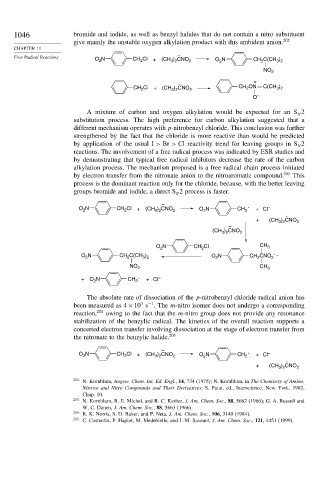Page 1062 - Advanced Organic Chemistry Part A - Structure and Mechanisms, 5th ed (2007) - Carey _ Sundberg
P. 1062
1046 bromide and iodide, as well as benzyl halides that do not contain a nitro substituent
give mainly the unstable oxygen alkylation product with this ambident anion. 202
CHAPTER 11
–
Free Radical Reactions
O 2 N CH 2 Cl + (CH ) CNO 2 O N CH C(CH )
3 2
3 2
2
2
NO 2
+
–
Cl (CH ) CNO CH ON C(CH )
CH 2 + 3 2 2 2 3 2
O –
A mixture of carbon and oxygen alkylation would be expected for an S 2
N
substitution process. The high preference for carbon alkylation suggested that a
different mechanism operates with p-nitrobenzyl chloride. This conclusion was further
strengthened by the fact that the chloride is more reactive than would be predicted
by application of the usual I > Br > Cl reactivity trend for leaving groups in S 2
N
reactions. The involvement of a free radical process was indicated by ESR studies and
by demonstrating that typical free radical inhibitors decrease the rate of the carbon
alkylation process. The mechanism proposed is a free radical chain process initiated
by electron transfer from the nitronate anion to the nitroaromatic compound. 203 This
process is the dominant reaction only for the chloride, because, with the better leaving
groups bromide and iodide, a direct S 2 process is faster.
N
–
O N CH Cl + (CH ) CNO 2 O N CH 2 + Cl –
3 2
2
2
2
+ (CH ) CNO 2
3 2
–
(CH ) CNO 2
3 2
O N CH Cl CH 3
2
2
O N CH C(CH ) O N CH CNO 2 –
2
3 2
2
2
2
NO 2 CH 3
+ O N CH 2 + Cl –
2
The absolute rate of dissociation of the p-nitrobenzyl chloride radical anion has
3
−1
been measured as 4×10 s . The m-nitro isomer does not undergo a corresponding
reaction, 204 owing to the fact that the m-nitro group does not provide any resonance
stabilization of the benzylic radical. The kinetics of the overall reaction supports a
concerted electron transfer involving dissociation at the stage of electron transfer from
the nitronate to the benzylic halide. 205
–
N CH Cl –
O 2 2 + (CH ) CNO 2 O N CH 2 + Cl
2
3 2
+ (CH ) CNO 2
3 2
202
N. Kornblum, Angew. Chem. Int. Ed. Engl., 14, 734 (1975); N. Kornblum, in The Chemistry of Amino,
Nitroso and Nitro Compounds and Their Derivatives, S. Patai, ed., Interscience, New York, 1982,
Chap. 10.
203 N. Kornblum, R. E. Michel, and R. C. Kerber, J. Am. Chem. Soc., 88, 5662 (1966); G. A. Russell and
W. C. Danen, J. Am. Chem. Soc., 88, 5663 (1966).
204 R. K. Norris, S. D. Baker, and P. Neta, J. Am. Chem. Soc., 106, 3140 (1984).
205
C. Costentin, P. Hapiot, M. Medebielle, and J.-M. Saveant, J. Am. Chem. Soc., 121, 4451 (1999).

